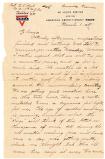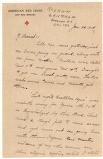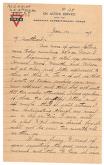|

WWI letter to Emily Gladys Bartlett

WWI letter to Emily Gladys Bartlett

WWI letter to Emily Gladys Bartlett

WWI letter to Emily Gladys Bartlett

WWI letter to Emily Gladys Bartlett

WWI letter to Emily Gladys Bartlett

WWI letter to Emily Gladys Bartlett
|
Summary and Objective
The students will learn that Americans living in a post-World War I setting did not believe that World War I was necessarily the war to end all wars. Students often critically analyze President Wilson and the Treaty of Versailles with 21st century perspectives. This collection of letters gives a voice to those Americans who opposed the League of Nations and where this level of international involvement might lead to. After completing a comparative timeline, students will compare the viewpoint of a different soldier of their choice.
Teachers should also note that the breadth of this collection is broad in scope and can be utilized to study other aspects of American culture during this time period. I have included a few key letters critical to this topic, but there are over a dozen letters available online and a total of 90 in the collection.
Teaching Plan
Step 1.
Students will have prior knowledge of World War I, including the U.S.' policy of isolationism.
Step 2.
Students will read President Woodrow Wilson's "14 Point" speech and discuss some of the suggestions including why countries were rewarded with more land than others.
Step 3.
Students will then be put into groups of 4 and read from Emily Gladys Bartlett's collection, especially the January-July 1918 and January-March 1919 letters. Each group should have different letters that match up chronologically.
Step 4.
Each group should discuss their findings in the letters. These discussions should be focused on his daily activities and his perspective of the war. This is key. They should be able to track the political and military advancements of the Allies and see how the Bartlett letters correspond with the evolution of the war. Bartlett does not enlist until April 1918 so students should consider why he waited to fight. They might wonder where Wirt ranks himself in comparison with world leaders, other soldiers, etc.
Step 5.
Next, each group should construct a timeline. If students have online access, they should complete an interactive multi-media timeline to present. Each section of the timeline should only cover the time period of their letters. Dividing the timeline in half (length-wise), students should write down Wirt's location, experiences and progress on top. Below the line, they should match him with relevant facts from the same segment of time (For example, his June 1918 experiences to those of the war overall). They may want to include battles, cities, political leaders, numbers of troops and any other relevant information.
Step 6.
Finally, students should present their timelines in chronological order to the class. Students should NOT just present facts but make connections between the overall war effort and Wirt. Students should discuss Wirt's perspective and consider what other factors are weighing on him (life or death, adjusting to home, U.S. foreign policy, etc.). Students should also consider how Wirt's focus changes post-War. Students may sense his anxiousness to get home.
Step 7.
As a wrap-up, students use one of the websites provided below and access a different soldier's collection of letters. Students could create mind maps (draw big heads, fill with "thoughts" and perspective) that compare and contrast Wirt with a soldier not necessarily from the United States. They can compare the different perspectives, why each was fighting and whether there is anything universal to a soldier's viewpoint. Students could then hang those mindmaps in the classroom for other students to study.
|




